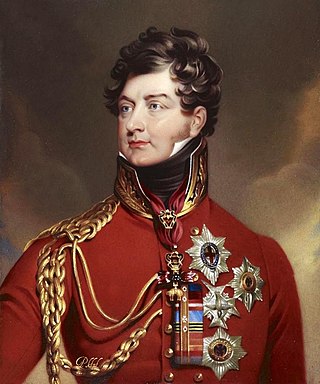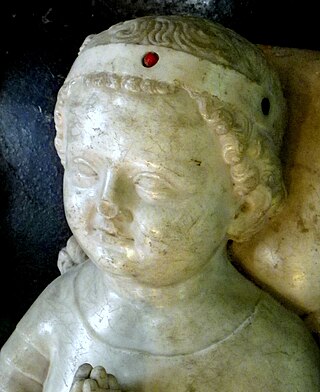Related Research Articles

A prince regent or princess regent is a prince or princess who, due to their position in the line of succession, rules a monarchy as regent in the stead of a monarch, e.g., as a result of the sovereign's incapacity or absence.

John I, called the Posthumous, was King of France and Navarre, as the posthumous son and successor of Louis X, for the five days he lived in 1316. He is the youngest person to be king of France, the only one to have borne that title from birth, and the only one to hold the title for his entire life. His reign is the shortest of any undisputed French king. Although considered a king today, his status was not recognized until chroniclers and historians in later centuries began numbering John II, thereby acknowledging John I's brief reign.

Charles VI, nicknamed the Beloved and later the Mad, was King of France from 1380 until his death in 1422. He is known for his mental illness and psychotic episodes that plagued him throughout his life.

The Lan Na Kingdom or The Kingdom of Lanna, also known as Lannathai, and most commonly called Lanna or Lanna Kingdom, was an Indianized state centered in present-day Northern Thailand from the 13th to 18th centuries.

Photisarath, son of King Visoun of Lanxang, is considered to be the most devout of the Lao kings. He banned spirit worship and built temples upon the sites of spirit shrines. His elephant fell and crushed him while he sought to display his prowess to the diplomatic corps. His son Setthathirath returned from Chiang Mai to succeed him to the throne of Lan Xang.
Samsenethai(Lao: ສາມແສນໄທ) also called Oun Huan(Lao: ອຸ່ນເຮືອນ) was the second king of Lan Xang in Laos. He succeeded his father, Fa Ngum.
A coregency is the situation where a monarchical position, normally held by only a single person, is held by two or more. It is to be distinguished from diarchies or duumvirates such as ancient Sparta and Rome along with a regency where the monarch in most cases infant or incapacitated particularly has a senior above him and exercises no power whatsoever apart from legally holding the position of Head of State.
Somphou was the king of Lan Xang from 1496 until 1501 AD. Succeeded on the death of his father King La Sen Thai in 1496. Reigned under the regency of his uncle, Prince Laksana Vijaya Kumara, until he came of age and died unexpectedly in 1501.
Chey Chettha II was a king of Cambodia who reigned from Oudong, about 40 km northwest of modern-day Phnom Penh, from 1618 to 1628. He was the son of King Srei Soriyopear. He is noted for moving the royal capital from Srei Sonthor to Oudong, and for his cooperation with the Nguyễn Lords of Vietnam against the Siamese, which led to the Vietnamese annexation of the Mekong Delta, including the city of Prey Nokor—the precursor of modern-day Ho Chi Minh City.

John of Sweden, Duke of Östergötland was a Swedish royal dynast. He was titular Duke of Finland 1590–1606 and reigning Duke of Östergötland 1606–18.
Nanda Bayin, was king of the Toungoo dynasty of Burma (Myanmar) from 1581 to 1599. He presided over the collapse of the First Toungoo Empire, the largest empire in the history of Southeast Asia.

Frederick III, Duke of Legnica was a Duke of Legnica during 1547–1551 and 1556–1559.

John Albert II, Duke of Mecklenburg[-Güstrow] was a Duke of Mecklenburg. From 1608 to 1611, he was the nominal ruler of Mecklenburg-Schwerin; the actual ruler being the regent, his great-uncle Charles I. From 1611 to 1621 John Albert and his brother Adolf Frederick I jointly ruled the whole Duchy of Mecklenburg. From 1621, John Albert ruled Mecklenburg-Güstrow alone.
Nawrahta Minsaw was king of Lan Na from 1579 to 1607/08, and the first Burmese-born vassal king of Lan Na. He was also an accomplished poet.
Sen Soulintha, Saen Surintha or Sen Sourintha (1511–1582) was born Chane Tian and became King of Lan Xang reigning from 1571-1575 and again from 1580-1582. Sen Soulintha was not of noble birth, rising from royal page to the position of King Setthatirath’s Chief Minister. During the succession disputes in the Kingdom of Lan Na between King Setthatirath and King Mekuti, Sen Soulintha served Setthatirath as a general and successfully took several cities of Lan Na including Chiang Saen for which he was given the honorific name Lusai meaning “victory.” Sen Soulintha supported Setthatirath in leading the guerrilla campaigns during the Burmese invasions of King Bayinnaung. When Setthatirath died near Attapeu under suspicious circumstances in 1572, Sen Soulintha led the armies of Lan Xang back to Vientiane. A succession dispute erupted, which nearly led to civil war and provided a pretext for another Burmese invasion ordered by Bayinnaung and led by the Chief Minister Binnya Dala. Sen Soulintha defeated the Burmese and Lan Na forces led by Binnya Dala, an event which led to the latter’s exile, only to face a more massive invasion led by Bayinnaug the following year. Sen Soulintha again attempted to resort to guerilla tactics, but lacked popular support from his seizure of the throne. He and his son Ong Lo were captured by Bayinnaung and exiled to Pegu. The Burmese placed Setthathirath’s brother, and former Ouphahat or Viceroy, Prince Tha Heua on the throne. According to the Luang Prabang chronicles it was this brother, who had led a rebellion in Luang Prabang and tried to seize the throne from Setthathirath on the death of their father Photisarath. Prince Tha Heua took the regnal name Voravongsa and reigned under Burmese suzerainty from 1575-1579. Voravongsa was never popular, and drowned with his family while attempting to flee Vientiane in the face of popular uprising. In 1579, Bayinnaung dispatched a sizable army to restore order. According to Lao histories Sen Soulintha was then installed as king a second time in 1580. By that time Sen Soulintha was an old man and reigned only for two years before his son ascended the throne as Nakhon Noi and another succession dispute ensued.
Nakhon Noi briefly occupied the throne of Lan Xang from 1582 to 1583 on the death of his father Sen Soulintha, who himself had been appointed as a vassal to the Toungoo Empire from 1580 to 1582. Nakhon Noi took the regnal name Samdach Brhat Chao Samdach Brhat Chao Negara Nawi Raja Sri Sadhana Kanayudha. Little is known about his brief rule, it does not appear in the sources that the Burmese were at the origin of his selection to succeed Sen Soulintha and were instead informed belatedly. If he had supporters in the royal court of Lan Xang they were few and quickly became unhappy with his rule. Within the year the royal court had petitioned King Nanda Bayin for his removal. According to various versions of the chronicles it is cited that Nakhon Noi “did not rule with fairness,” or keep to the religious and behavioral precepts which were traditionally required by a sovereign. Other versions record that he simply had made enemies at court, or was perceived as illegitimate because he was of common origins. Either at the hands of the royal court, or the Burmese, Nakhon Noi was deposed, arrested, and returned to Pegu. After Nakhon Noi was deposed a period of interregnum occurred from 1583 to 1591 which historian Paul Le Boulanger describes as a period of “absolute confusion,” among the factions at court. The chronicles again agree that it was only after the period of succession crisis that a petition was finally sent in 1591 to Nanda Bayin by the Lao sangha and Lan Xang court asking for Prince No Muang, the son and legitimate heir of Setthathirath, to be appointed as king. Nanda Bayin confirmed the request and Prince No Muang would take the throne as Nokeo Koumane and reign Lan Xang from 1591 to 1596.
Keo Koumane, or Nu Muang Kaeva Kumara, Nokeo Koumane was born No Muong (1571–1596) was King of Lan Xang reigning from 1571 till 1572 and from 1591 till 1596. He was the son of King Sai Setthathirath I by his wife, "Kaew Pra Kham" a daughter of King Sen Soulintha.
Ouphagnauvarath I was the King of Lan Xang for nine months (1621-1622). He was born in 1597 as the son of Lan Xan King Vorouvongsa II. Later he was appointed as Heir Apparent with the title of Upyuvaraja. He deposed his father and seized the throne in 1621 reigning for nine months. He died under mysterious circumstances in 1622.
Mon Keo was the king of the Laotian Kingdom of Lan Xang between 1627 and 1633, Reigning with the regnal name of Samdach Brhat-Anya Chao Manikya Kaeva Raja Sri Sadhana Kanayudha, he was the son of King Voravongsa II and brother of King Ouphagnauvarath I.